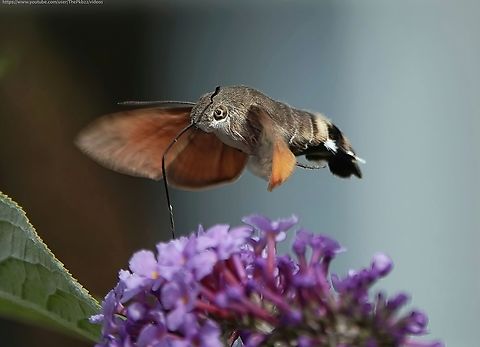
Naming
The hummingbird hawk-moth was first described by Carl Linnaeus in his 1758 10th edition of "Systema Naturae". As of 2018, its entire genome and mitogenome have been sequenced.
Distribution
The hummingbird hawk-moth is distributed throughout the northern Old World from Portugal to Japan, but it breeds mainly in warmer climates. Three generations are produced in a year in Spain.It is a strong flier, dispersing widely in the summer. However it rarely survives the winter in northern latitudes.
Moths in the genus "Hemaris", also of the family Sphingidae, are known as "hummingbird moths" in the US, and "bee moths" in Europe. This sometimes causes confusion between this species and the North American genus.
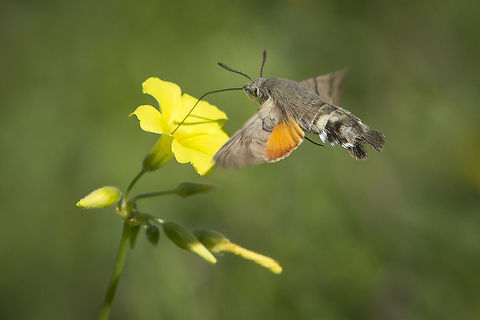
Behavior
Two or more broods are produced each year. The adult may be encountered at any time of the year, especially in the south of the range, where there may be three or four broods. It overwinters as an adult in a crevice among rocks, trees, and buildings. On very warm days it may emerge to feed in mid-winter. Unlike other moths, they have no sexual dimorphism in the size of their antennal lobes.Its long proboscis ) and its hovering behavior, accompanied by an audible humming noise, make it look remarkably like a hummingbird while feeding on flowers. Like hummingbirds, it feeds on flowers which have tube-shaped corollae. It should not be confused with the moths called hummingbird moths in North America, genus "Hemaris", members of the same family and with similar appearance and behavior.The resemblance to hummingbirds is an example of convergent evolution. It flies during the day, especially in bright sunshine, but also at dusk, dawn, and even in the rain, which is unusual for even diurnal hawkmoths. "M. stellatarum" engages in free hovering flight, which allows more maneuverability and control than fixed-wing flight, despite high energetic cost. Like many large insects, it relies upon Johnston's organs for body positioning information.
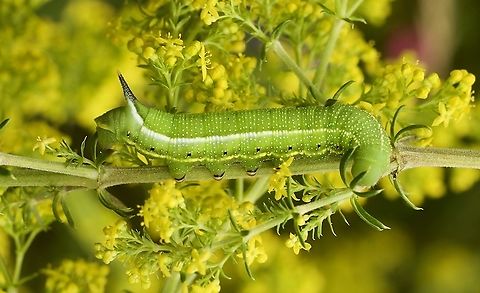
Habitat
Hummingbird hawk-moths can be easily seen in gardens, parks, meadows, bushes, and woodland edge, where the preferred food plants grow.Their larvae usually feed on bedstraws or madders but have been recorded on other Rubiaceae and "Centranthus", "Stellaria", and "Epilobium".
Adults are particularly fond of nectar-rich flowers with a long and narrow calyx, since they can then take advantage of their long proboscis and avoid competition from other insects. Flowers with longer tubes typically present the feeding animal a higher nectar reward. Proboscis length is thought to have been evolutionarily impacted by the length of flower feeding tubes. Examples of such plants include "Centranthus", "Jasminum", "Buddleia", "Nicotiana", "Primula", "Viola", "Syringa", "Verbena", "Echium", "Phlox", and "Stachys". They are reported to trap-line, that is, to return to the same flower beds at about the same time each day.
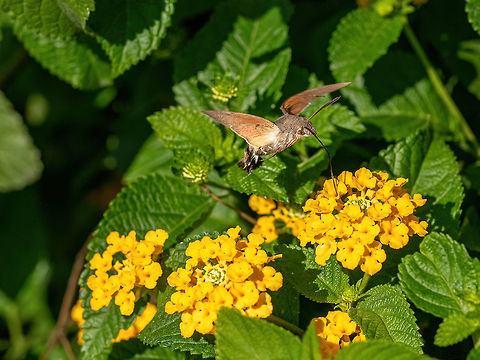
Reproduction
Newly hatched larvae are clear yellow, and in the second instar assume their green coloration. The larva is green with two grey stripes bordered in cream along the sides and with a horn at the rear end typical of sphingids. The horn is purplish red, changing to blue with an orange tip in the last instar. They feed fully exposed on the top of the host plant and rest in among a tangle of stems. Although dependent on warmth and sun, the larval stage can be as rapid as 20 days.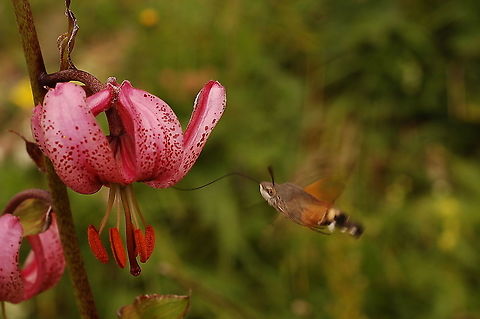
Cultural
Hummingbird hawk-moths have been seen as a lucky omen. In particular, a swarm of the moths was seen flying across the English Channel on D-Day, the day of the Normandy landings in the Second World War. These moths, along with other moths, are in the family Sphingidae because their larvae were thought to resemble the Egyptian Sphinx.References:
Some text fragments are auto parsed from Wikipedia.